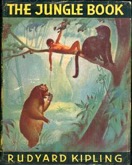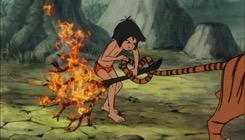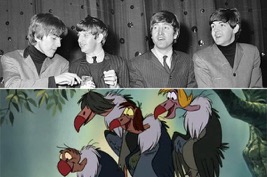
The Jungle Book (1967) Walt Disney
Synopsis
Having been raised by a pack of wolves, with a black panther and a bear as your two closest companions, you would think you would have no troubles, but for Mowgli this is untrue. The Jungle Book is a Disney adaptation of Rudyard Kipling’s book of the same name, following the adventure of Mowgli, the man-cub on his journey back to human civilization to the ‘man village’. At ten years old, Mowgli has known nothing other than a life in the Indian jungle after being raised by a pack of wolves. The film explores the theme of discovery and Mowgli’s struggle to identify himself as a human rather than every animal he meets on his travels. His reluctance to return to human civilization is juxtaposed with the intentions of his animal companions, Baloo the bear and Bagheera who try to protect Mowgli from the dangers of the jungle, in the form of Shere Khan, the infamous tiger representing the dangers of crossing species boundaries. The adaptation of this film from Kipling’s book has in fact restored and replaced the text as a film in the popular imagination. At the time of publication, the book became a widely known and loved literary classic. Since then, Disney has revived the text into a film that we now refer to when we think of The Jungle Book.

Genre
“Family adventure films are very often fantasy films, with wild and imaginative themes and plots that involve a journey, helpful and friendly creatures, and settings in fantastic, far-away worlds”[1] which is a description well suited to this film. The Jungle Book is a feature-length animated film and this stylistic technique allows for a hybrid of genres to be explored. In this case, The Jungle Book provides elements of adventure, family and also slapstick comedy, which work well together. The animation component is a crucial feature to break the normal real- life conventions that we are used to. The fact that all of the animals can talk in English and Baloo, unlike a normal bear, walks on his hind legs throughout, allows the audience to refrain from taking everything too literally. Family orientated films ‘often include a child actor and themes that teach a lesson, or show that good can triumph over evil’ [2] and again this is evident through the child character of Mowgli triumphing over the ‘evil’ Shere Khan.
Animal Presences
The Jungle Book just wouldn’t be worth watching if the presence of animals was not integral to the plot as the enjoyment of watching cartoon animals in a family film, becomes crucial to the viewing experience. The title itself leads us to believe that animals are going to play an essential feature in this film, and it does not disappoint. There are over eleven species of animal featured and the use of anthropomorphism is deliberately presented in all characters to generate a particular response from the audience to sympathise with certain characters and perhaps not others. Each animal embodies differing values and personalities, which we as an audience, identify with according to traits that we would typically associate with human nature. Bagheera is the first of many animals we see in the film and as a wild black panther, he would usually be an animal that humans would avoid however in contrast, he is portrayed as the voice of reason throughout the film and adopts the position of Mowgli’s guardian.
Mowgli as the central character can also be considered as one of the ‘animals’. Immediately, we see a confusion of identity, as Mowgli is frequently referred to as the ‘man-cub’. This could be interpreted as a human/animal hybrid as he’s not distinguishably one or the other at this point. We see that at ten years old, Mowgli howls at the wolves creating an immediate blurring of human/animal characteristics. He would be what is known today as a feral child; however Mowgli does not seem to embody many other wolf traits as you might expect. Throughout the film, he walks on his hind legs and faces struggles of adapting to animal life as a human child. This could suggest that some human traits are inherent and the animated nature of the film allows this to not be something questioned too much. He faces many challenges in the jungle, which he has to overcome, typical to the genres. Mowgli clearly isn’t fully equipped to survive alone in the jungle because fundamentally he is human. This is emphasised in the scene where he is unable to climb the tree without the help of Bagheera as he does not possess the physical traits of a wild animal such as big claws. It is unsurprising that Mowgli has difficulty in finding his identity, as during his journey across the jungle, he meets many different species of animal, which he aspires to become. He tries to adopt traits of an elephant, a monkey and a vulture however he is not fully equipped to embody sufficient characteristics to be like any one of them. This is also the case when Mowgli meets Baloo the bear, a loveable, clumsy character who takes a shine to him. Baloo is more than willing to try and help Mowgli stay in the jungle by teaching him the bear way of life. He tries to teach him how to “fight like a bear” but through the comic element of the scene, we laugh at Mowgli’s poor effort to roar like a bear.
Baloo asks “Mowgli, don’t you realise you’re a human?” to which Mowgli responds “I’m not anymore Baloo” emphasising his naivety in thinking he can cross the human/animal boundary with no real consequences. This follows from Bagheera explaining “You can’t adopt him as your son. You wouldn’t marry a panther would you?” whilst representing a level headed, voice of reason, showing how species are one of their own and there are boundaries that shouldn’t be crossed. At this point, Bagheera realises that Mowgli should never have been in the jungle, and should have been brought up by his own kind, as consequentially; he has no sense of identity. This is again affirmed through his confusion of seeing a young human girl at the river.
The tale is not only about identity, but also friendship. Mowgli makes a friend in many of the animals as he feels neglected by his own kind and constantly reminds us that “I don’t want to go back to the man village!” showing his detachment from the human world and his longing to be a part of the animal world. Mowgli’s identity struggles stem from his resistance to accept his human identity, and throughout the film, there is a clear reluctance to embrace his human status. He knows where he came from, but doesn’t consider it home. This is where the confusion arisesde, as he cannot recognise why Shere Khan wants to kill him. Ironically Shere Khan is the most feared by all the animals, and yet he fears Mowgli. All the other animals explain that Shere Khan hates ‘man’ and describes any human as “just another hunter with a gun”. They have two separate worlds and more often than not, the only time tigers experience human presence, is whilst being hunted. This confuses Mowgli as he doesn’t consider himself a normal ‘man’. Shere Khan fears a man’s gun and a man’s fire, so becomes threatened by humans in his territory.

Animal Representation
It is important to consider the time that The Jungle Book was released and this context is helpful to understand some of the representations of the animals. ‘Walt Disney uses exaggerated characterizations to represent threats in the late 60’s’[3] such as liberal parenting, through the character of Baloo, the trouble of women’s liberation which is very evident through the lack of prominent female characters. The Rock n’ Roll hippie movement is also evident through the four vultures with their wacky hairstyles. They are supposed to embody the four members of The Beatles who were even asked to be the voices of these characters in the film.[4] The gender struggles at the time are also portrayed in this film through the lack of female characters. There is only one female elephant character who speaks throughout the whole film and the male elephant undermines her importance by saying “A female leading my pack? Preposterous!” The other female is the young human girl, who is used almost as an object to entice Mowgli into the ‘man village’ and has no speech in the film whatsoever. This emphasises the female struggle for equality at the time the film was produced. Lastly however, many critics noticed a form of racism in the film through the characters in the monkey kingdom. The monkeys can be seen to be the black members of society at the time and it was the African Americans who originated swing music [5]. This hardly seems a coincidence that the song King Louie sings features the line ‘I’m the King of the swingers’ and also the song states ‘I wanna be like you, wanna walk like you, talk like you..’ which many people identify with the black community desiring to be like the white people. In the film, Louie is obsessed with discovering how to make fire, as that is something only humans can do, and he wants to be able to do the same things as man can, which is why it is often referred to as having a link to the civil rights movement at the time.

Connection to another film
5) In The Jungle Book, I can see similarities to the film Born Free (1966) as I believe the themes and messages are very similar. Although one is completely fictional, and the other based on a true story, the ideas are very similar. The idea of an animal being taken out of its ‘natural habitat’ is a theme running through both films, except one is a human rather than a lion. Nonetheless, the outcome and problems are scarily similar. Although they are both returned to where they rightfully belong, there is a sense of selfishness from the ‘adoptive parents’ who want to keep them in their world and consequentially make life harder, in the sense that it is near impossible for either to live in the wild or in the human realm. We see that in both films, the characters are tested by the desire for a connection amongst humans and animals and how far they will go to enhance this connection. Thus, suggesting that boundaries between some species should never be crossed as it can have detrimental effects. Both films explore the idea of not only wildness, but the theme of autonomy and how constraints placed on either a feral child or a domesticated lion, can limit the access to autonomy. It is also interesting to note that we are never shown the human realm in The Jungle Book and the film begins with an establishing shot of the human village, then a tracking shot of the jungle in very close proximity. This again shows how the two species can often physically live close, but the boundaries shouldn’t be crossed, and this is shown as almost an ‘unspoken rule’, which is broken in both films.
[1]Dirks, T. (2012). Children-Kids Family films. Available:http://www.filmsite.org/childrensfilms.html. Last accessed 24th Nov 2015.
[2]Dirks, T. (2012). Children-Kids Family films. Available:http://www.filmsite.org/childrensfilms.html. Last accessed 24th Nov 2015.
[3] Waterman, A. (2015). Perceptions of Race in Three Generations of The Jungle Book. AMIRI BARAKA: REVALUATION AND APPRECIATION. 1 (2)
[4] Franks-Allen, S. (2013). 10 Things You Didn’t Know About The Jungle Book. Available:http://screencrush.com/things-you-didnt-know-about-disneys-the-jungle-book/ Last accessed 21st Jan 2016.
[5] Waterman, A. (2015). Perceptions of Race in Three Generations of The Jungle Book. AMIRI BARAKA: REVALUATION AND APPRECIATION. 1 (2)
Further Reading suggestions
1)Dirks, T. (2012). Children-Kids Family films. Available: http://www.filmsite.org/childrensfilms.html.
2)Waterman, A. (2015). Perceptions of Race in Three Generations of The Jungle Book. AMIRI BARAKA: REVALUATION AND APPRECIATION. 1 (2)
3) http://wikis.la.utexas.edu/deutsche_kultur/students/25/imperialism-kiplings-and-disneys-jungle-book-final-draft
4) http://www.popoptiq.com/28-days-of-disney-animation-the-jungle-book-and-racism-in-disneys-animated-features/
Bibliography
1) Dirks, T. (2012). Children-Kids Family films. Available: http://www.filmsite.org/childrensfilms.html. Last accessed 24th Nov 2015.
2) Franks-Allen, S. (2013). 10 Things You Didn’t Know About The Jungle Book. Available: http://screencrush.com/things-you-didnt-know-about-disneys-the-jungle-book/ Last accessed 21st Jan 2016.
3) Waterman, A. (2015). Perceptions of Race in Three Generations of The Jungle Book. AMIRI BARAKA: REVALUATION AND APPRECIATION. 1 (2)
4) Waterman, A. (2015). Perceptions of Race in Three Generations of The Jungle Book. Available: http://continuumjournal.org/index.php/33-volumes/issues/vol-1-no-2-amiri-baraka-revaluation-and-appreciation/vol-1-no-2-content/ysc-1-2/94-perceptions-of-race-in-three-generations-of-the-jungle-book. Last accessed 24th Nov 2015.